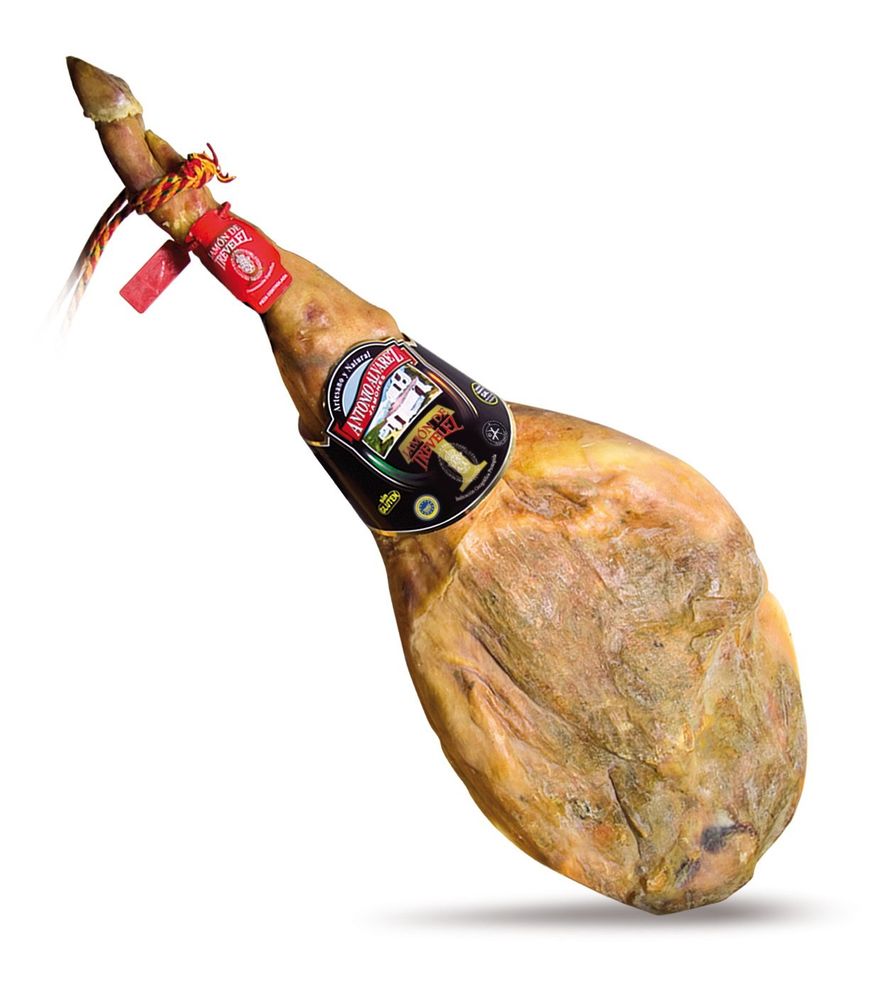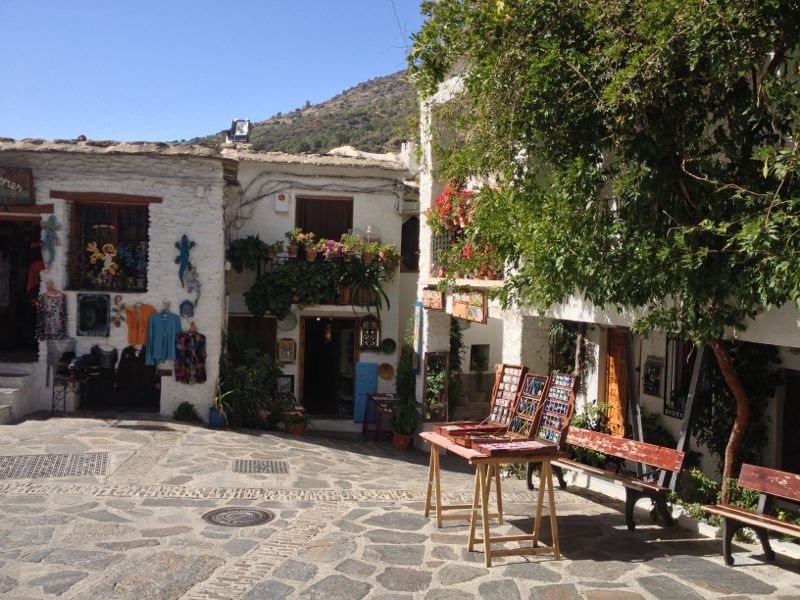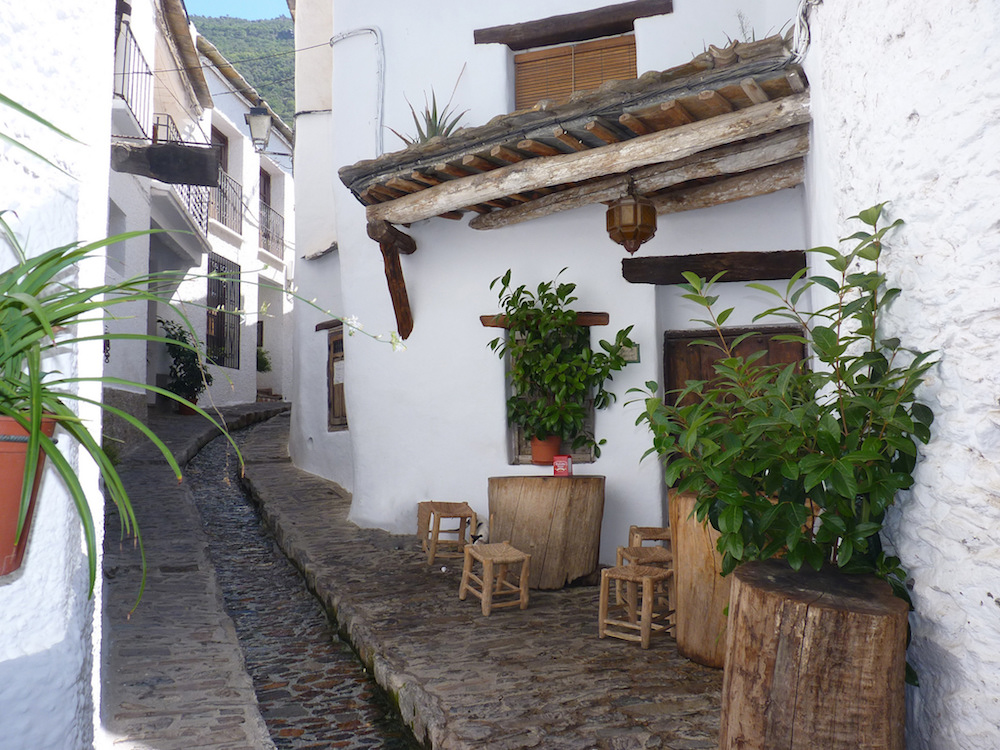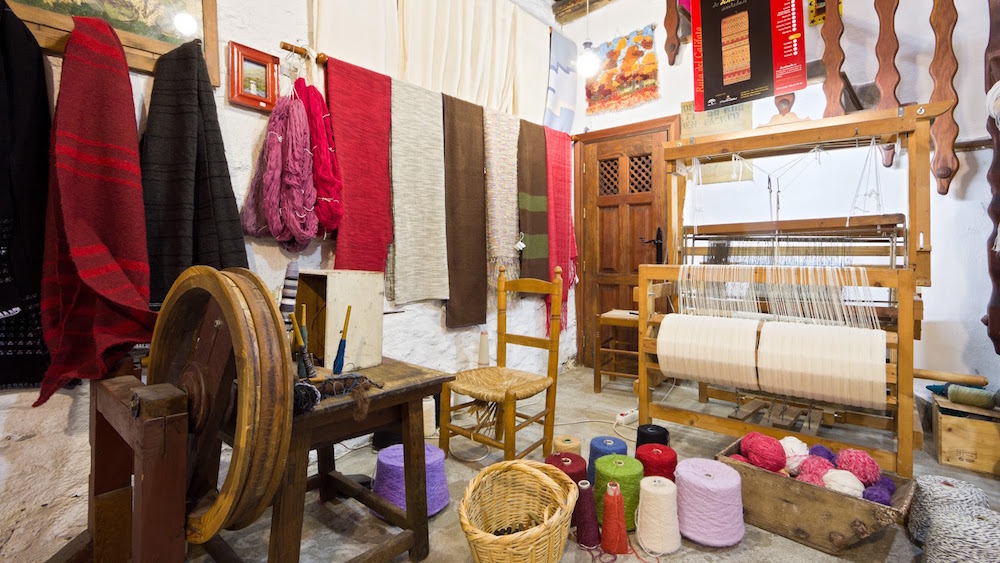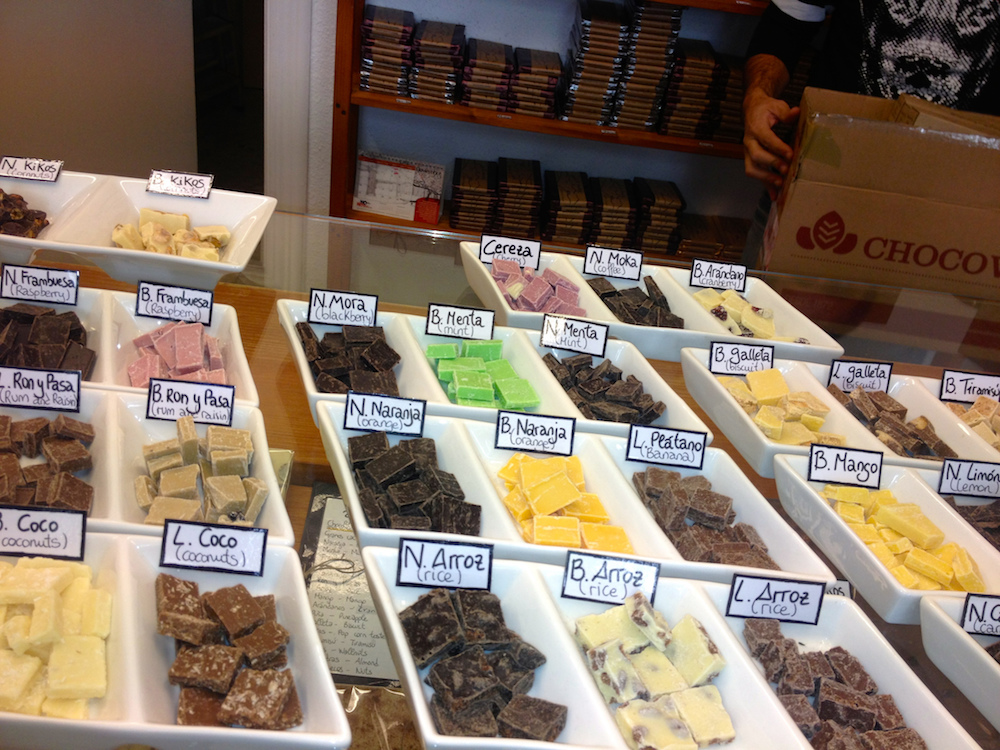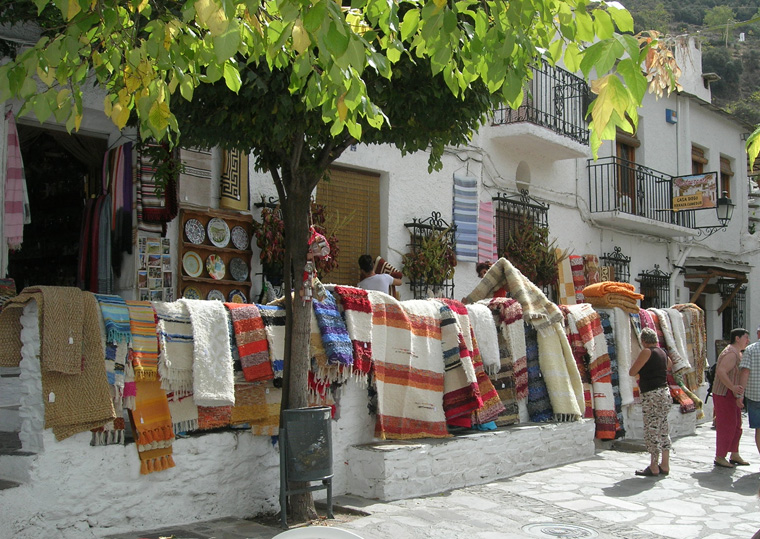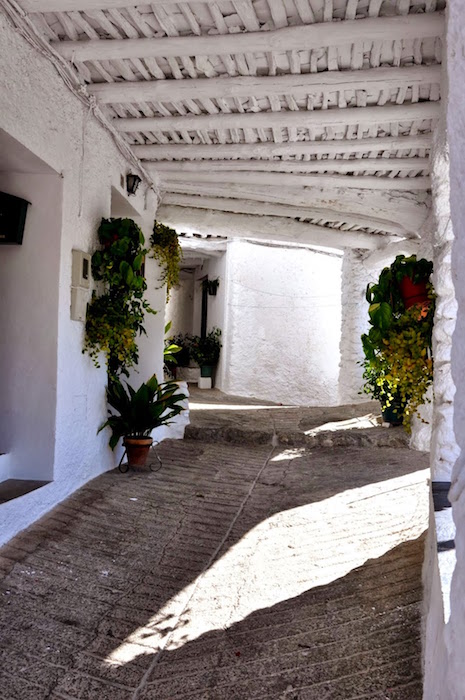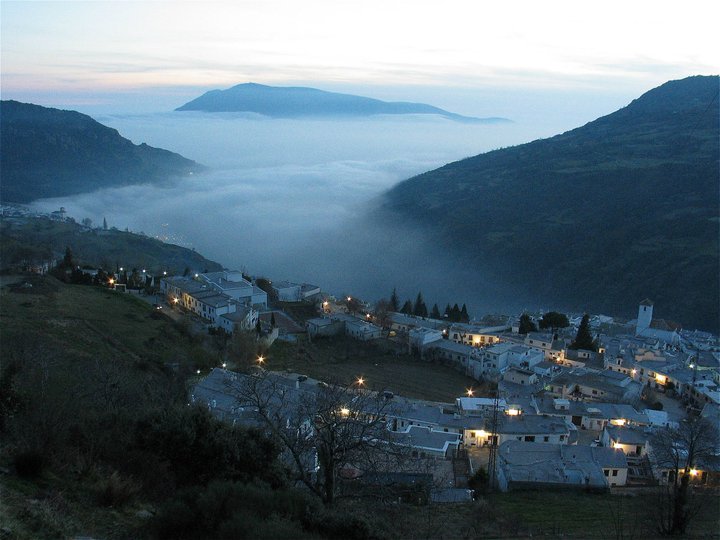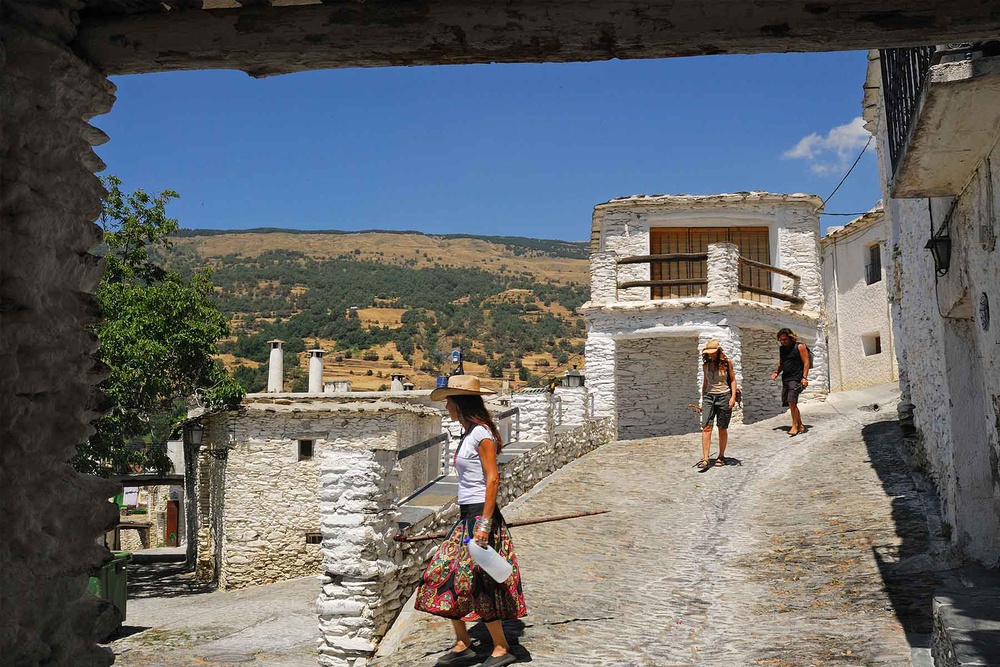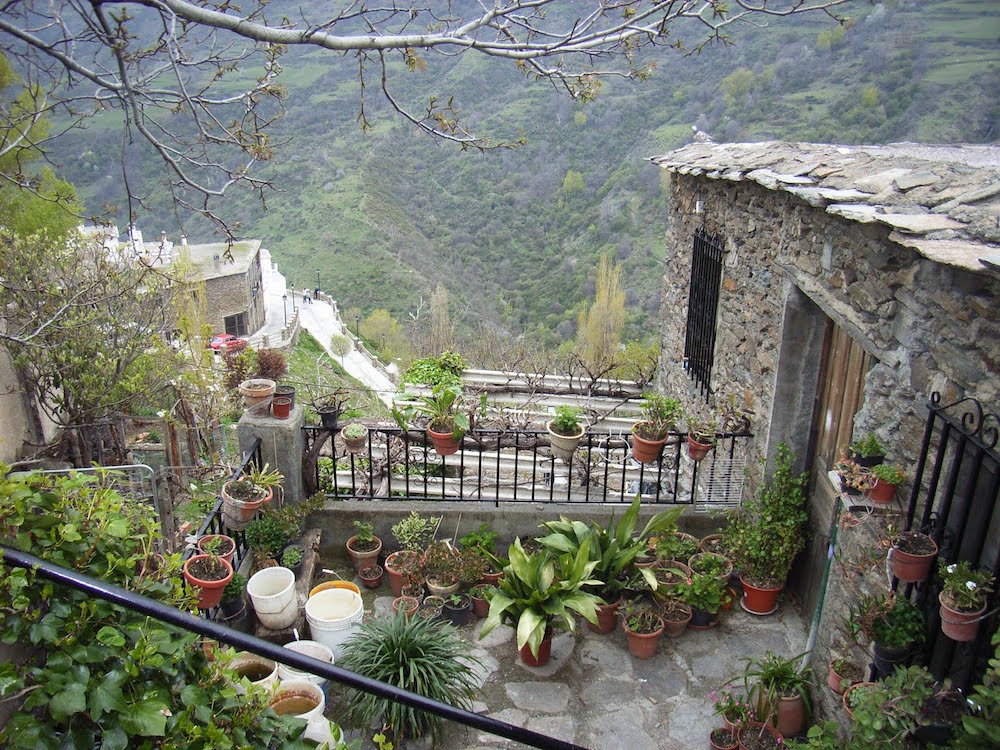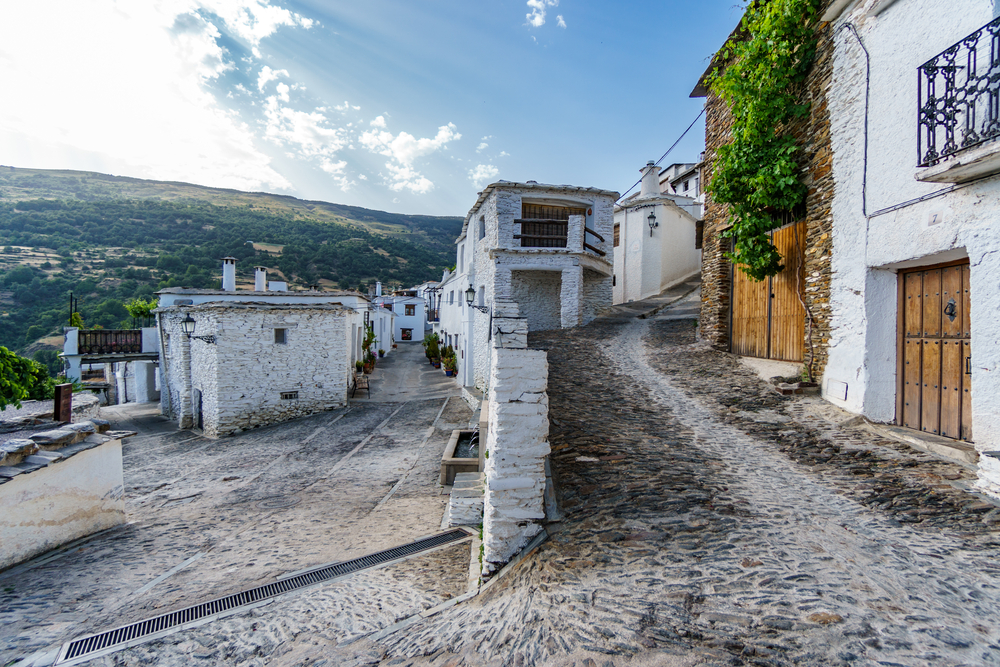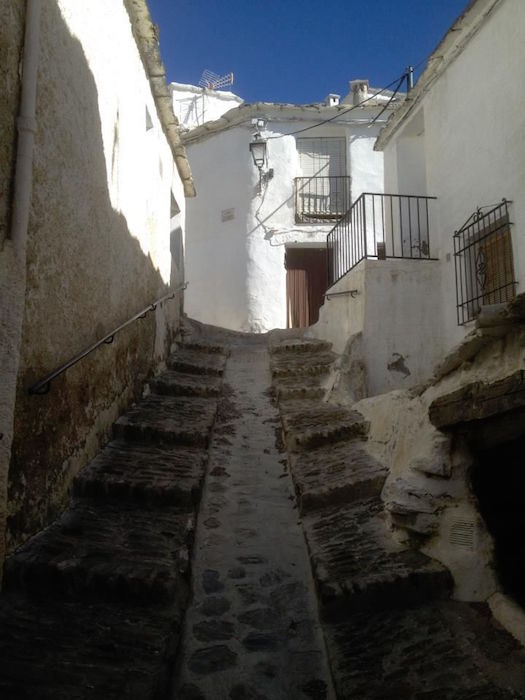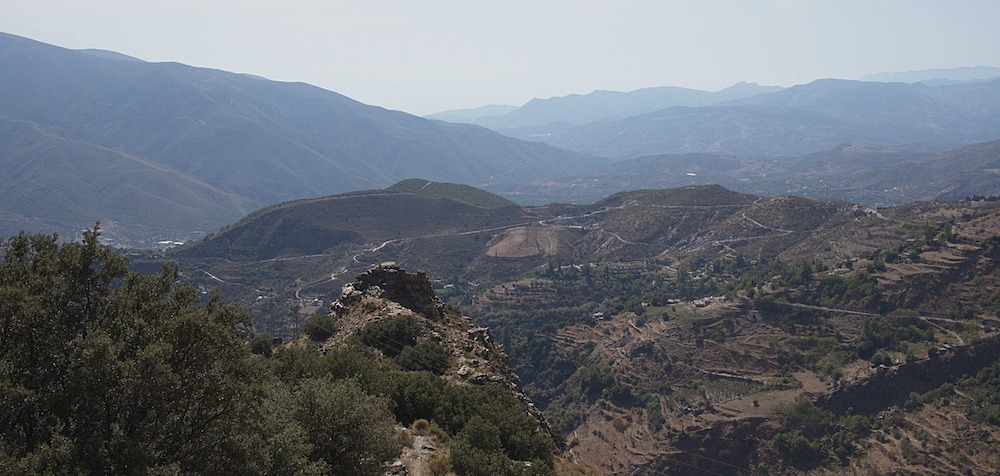
An excellent day out is to head up into the high Alpujarra to explore. Stop off to soak in the most amazing panoramas from the numerous viewing points, visit the white villages, drive up to the Sierra Nevada National Park, enjoy one of the many walks, go bird watching - the list of things to do is endless!
There are many white villages to explore but for now let us concentrate on three of them, Trevélez, Pampaneira and Capileira. The last two are in the Poqueira valley and there are plenty of locally made colourful rugs and piles of baskets made with esparto grass. Also in these villages there is a wide choice of Andalucian ceramics. In Capileira, G Browne makes leather clothes, bags and belts, and in Pampaneira there are hand-made leather shoes. In many of these workshops you may see this artisan work actually created, including old fashioned looms where scenic picture wall hangings are made of wool.
Trevélez
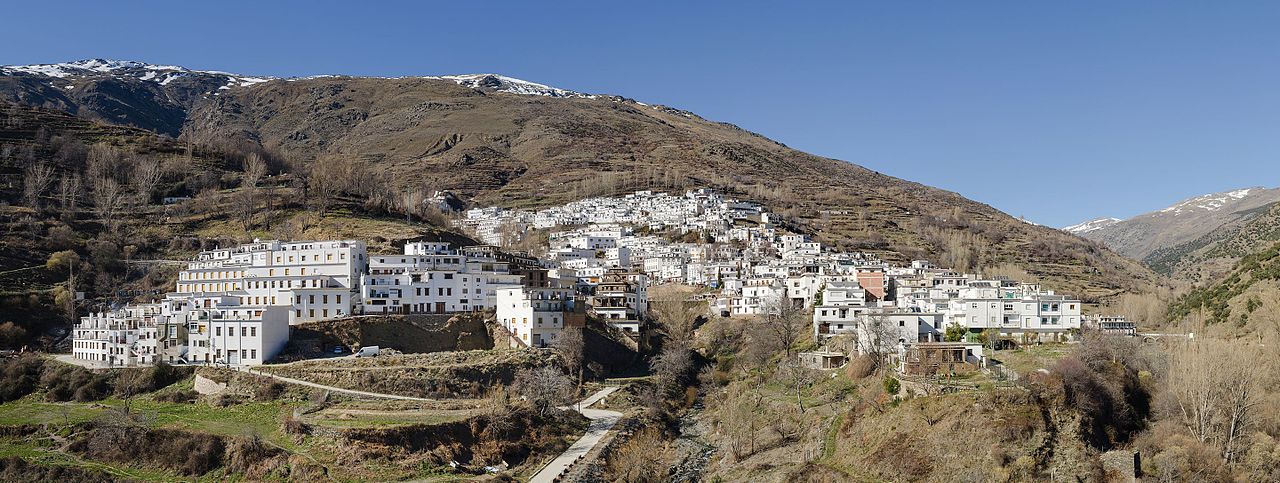
It is difficult to pinpoint the origins of this area, but it is believed that the first inhabitants settled here before the arrival of the Muslims. There are also differing opinions regarding the town’s name. Some believe that the village is named after the three Vélez brothers, who were the first settlers here and lived in different parts of the valley. Another version goes that the name is of Iberian-Latin origin and refers to the valleys (‘velex’) where the village is situated: the valleys of the Río Chico and the Río Grande.
The first written reference dates back to the Mozarab period in the 9th century, when the area fell under the Jurisdiction of the Taha de Juviles. After the Reconquista the town supported the Moorish uprising; when the rebellion was put down the Moors were expelled from the area, which was repopulated with Christians from other parts of Spain. Before suffering the consequences of the Muslim uprising, the town had one large mosque and two Rabitas, and the area enjoyed excellent wheat and barley harvests. In later centuries, thanks to its climate, Trevélez developed an important pork industry.
Most well-known for its mouth-watering cured ham, jamón serrano, the village of Trevélez is the highest in mainland Spain, at 1,486m. Its clear mountain air is ideal for drying the sweet-tasting ham, which has its own Denominación de Origen. Try it for yourself at any of Trevélez´s many bars, which have hams hanging from the ceiling. Local specialities made with ham include habas con jamón (broad beans and ham) and fresh trout (trucha).
Located at the head of the steep-sided and dramatic Trevélez river valley, the village′s population of around 800 is divided between three barrios: bajo, medio and alto. The lower section, Barrio Bajo, is the most touristy out of the three, and has the highest concentration of handicraft shops, bars and places to stay.
Trevélez is a great starting point for many walks with a well-trodden track leading from the village. It is also the starting point for trips to Las Siete Lagunas, seven impressive glacial lakes set in the mountains. For a shorter stroll, take the road next to the police station that crosses the Río Chico from Barrio Medio. This leads to the Era de la Cruz, an old threshing floor from where there are fine views over the village and valley. A popular walking route up to the summit of Pico de Mulhacén starts in Trevélez and the round trip is a two day hike. This route is one of four main routes up Mulhacén and passes through forest and open mountain expanse.
On the feast day of San Antonio (13-14 June) is a dramatic re-enactment of the battle between the Moors and the Christians, the Moros y los Cristianos. As the Alpujarras were the last redoubt of the Moors in the late 15th century, this is a particularly apt theme for a village in the region. You can see similar spectacles in the villages of Válor (14-15 September) and Pampaneira (3 May).
If you´re visiting in early August, don′t miss the village pilgrimage to a tiny shrine on the Mulhacén. The locals of Trevélez go on a pilgrimage up to the Mulhacén at night in order to watch the sunrise from the highest peak of the Sierra Nevada. The Romería de la Virgen de las Nieves is dedicated, as its name suggests, to the Virgin of the Snows, although Mulhacén rarely has snow on its summit in the height of summer. The traditional belief is that this will keep travellers safe in the Sierra Nevada for another year.
Trevélez ham
The ham is manufactured from top quality white pork leg and sea salt and contains no other preservative or additive. It is naturally cured following traditional methods. The process of drying and curing lasts at least 14 months after which the ham has acquired all the aromas and flavour. This process of natural curing can be extended to 30 months.
This product is classified under the Designation of Origin “Trevélez Ham”. Trevélez Ham is more than a natural, healthy, top quality food, it is a matter of culture. In 1862 Queen Isabel II granted Trevélez the privilege of stamping her crown on all hams manufactured in this region. Since then and for almost two hundred years, every generation has passed on the knowledge and the handmade processes of selection, salting and drying that make Trevélez Ham unique.
Trevélez Ham is manufactured under the Specific Designation of Origin “Trevélez Ham”, considered by European standards as P.G.I. (Protected Geographical Indication).
The production is regulated by Order APA/2859/2004 by which the Regulation of Specific Designation of Origin as “Trevélez Ham” is confirmed. The Regulating Council controls the raw materials and the manufacturing process guarantying it to be specific to that area.
Real Trevélez Ham must have an inviolable numbered seal on the leg which is black, red or blue depending on the size of the piece. The logotype “Jamón de Trevélez” is registered property of the Regulating Council. Its use is restricted to Trevélez Ham only, no matter how it is presented, and it guarantees the authenticity of the product.
Pampaneira

One of a trio of popular and picturesque whitewashed villages, Pampaneira - like its neighbours Bubión and Capileira - hugs the steep slopes of a lush river gorge, the Barranco de Poqueira. Pampaneira is the lowest of the three, at just over 1,000m.
The small village - with a population of around 300 - centres on its pretty square dominated by a 16th-century Mudéjar church, the Iglesia de Santa Cruz, with a wooden coffered ceiling and a couple of gilded altarpieces dating from the 17th and 18th centuries. Next to the church is the main square, the Plaza de la Libertad.
A corner of the Plaza de la Libertad off which there is a delightful street with acequia running down its middle. Further down this street is a delightful Bodega which has cured serrano ham, sausages, goat and sheep cheeses, meringues, wines and all sorts of other locally preserved produce, buddhas, Moroccan lights and many other things, all beautifully displayed in a typical Alpujarran building.
There are several bars and restaurants in the village, one of the most attractive being Ruta del Mulhacén, tel. 958 763 010. This has wonderful views up and down the Barranco de Poqueira. From the terrace you can see Veleta peak. Enjoy a drink and free tapas or experience the full flavours of the Alpujarras with a dish from their wonderful menu.
You will see a number of streets with acequias running down their middles. These are designed to carry the spring water coming off the mountains through the village without causing flooding.
There are several handicraft shops selling a wide range of products, many of them unique to the Alpujarras. One shop you should really visit is the textile workshop (Taller Textil) of Mercedes Carrascosa on Calle Aguila, tel. 958 76 30 41.
The textile workshop (Taller Textil) of Mercedes Carrascosa
For tourist information on the Alpujarras, visit Nevadensis on the main square, the Plaza de la Libertad, tel. 958 763 127. It sells maps and has details of walks in the area, along with a wealth of activities in the Alpujarras, the Sierra Nevada and Granada province. These include guided walks, horse treks, four-wheel drive excursions, rock climbing and mountain bike tours.
In Pampaneira there is also a wonderful chocolate factory, Chocolate Abuela ili, on the Plaza de la Libertad, tel. 958 98 16 86. Here you can sample the huge variety of chocolates where the slabs of many different flavours look like works of art and taste divine. They have a wide variety of ice-creams, made with real fruit, chocolate or coffee.
Just part of the huge selection of chocolates to choose from
Some of the wonderfully colourful rugs that are unique to the Alpujarras
Less than 2km outside Pampaneira is a Tibetan Buddhist monastery, O Sel Ling, located at a height of 1,600m. The centre was founded in 1980 by the Tibetan Lamas Ven. Lama Yeshe and Ven. Lama Zopa Rinpoche. Both belong to the Guelugpa tradition of Tibetan Buddhism, whose highest representative is His Holyness the 14th Dalai Lama, who came to visit in 1982 and gave the centre its name, which means Place of the Clear Light. From its stupa are spectacular views of the Sierra Nevada, the coast and Órgiva. The purpose of this place is to facilitate intensive meditation practise and spread the teachings of the Buddha in the Mahayana tradition of Tibetan Buddhism. To offer a place and space to be able to look inside and discover the nature of our mind and how it functions.
Walking routes along the Barranco de Poqueira are clearly marked with signposts and link the three villages.
Also, on the outskirts of Pampaneira, is a waterfall on the Poqueiro river close to the hydro electric power station.
The Alpujarran mountain villages were built at the time of the Moorish occupation. Their design is very similar to the Beber villages you can see in the Atlas mountains in Morocco.
Capileira

The highest of the three villages in the Barranco de Poqueira at 1436m. There is a considerable altitude difference between the oldest part of the village, which is at the lower, southern end, and the highest part, where tourist-oriented development is currently concentrated. Capiliera has been declared "Uno de los pueblos mas bonitos de Espana”, one of the most beautiful villages in Spain.
Capileira is a good base for walking in the gorge itself or up to the Sierra Nevada. Its twisting, steep streets are dotted with many springs gushing with fresh mountain water and there are superb views of the Poqueira gorge and the Sierra Nevada everywhere you look. With a population of 600, it′s also the largest of the three villages in the Poqueira gorge and it has a good choice of accommodation and bars. There is a market on Tuesdays.
Capileira′s remote location meant that Moorish rule arrived relatively late here, as did that of the Christians, who conquered the village centuries later. In the early 16th century, the Catholic Monarchs ordered the construction of the village church, the Iglesia de Nuestra Señora de la Cabeza, on the site of a former mosque. The original church was replaced with the current Mudéjar-style building in the 18th century.
On Calle Mentidero is the village′s museum, the Museo Etnológico Pedro Antonio Alarcón, which has exhibits of local handicrafts and dress and a display on the 19th-century writer Alarcón, from Guadix, who published an account of the Alpujarras, Viaje a la Alpujarra. It′s open 11am-2.30pm Tuesday to Sunday.
In Capileira delicious bread is still baked in Arab ovens and is perfect for either dipping or for accompanying the traditional La Alpujarra dish made of fried potatoes, fried egg, ham, marinated tenderloin, chorizo and morcilla. Game is often used in the local cuisine. Another typical recipe is the Capilurrio Choto and fennel stew. Delicious hams are also cured in the area.
For the most outstanding views of the village and the Poqueira gorge, head north towards the river and you′ll come to the Eras de Aldeire, a series of old threshing floors that were used for wheat and barley. On the southeastern edge of the village is a viewpoint (mirador) from where you can see down the Poqueira valley to Bubión and Pampaneira and north to the Veleta peak.
Although the Sierra Nevada Highway runs through Capileira and out across the Sierra Nevada mountains towards the city of Granada, motor traffic is no longer permitted to continue across the mountains, although you can continue to a car park where the National Park begins and the road is barred to normal traffic. The National Park runs a limited bus service on the now-closed road (reservations handled by an office in the village) in summer. A track leads northwards from the village to the abandoned settlement of La Cebadilla, built to house the workers who developed the hydro-electric installation at the upper end of the Poqueira Gorge.
For a truly away-from-it-all experience, you can stay in the mountain refuge beyond Capileira, the Refugio Poqueira (tel. 958 343 349). Located at 2500m en route to Mulhacén peak, there are spectacular views of the Sierra Nevada and the Alpujarras.
If you want to hike up to Mulhacén you can take a bus from Capileira (in summer only) to the Mirador de Trevélez. From here (2700m) you can climb up to the peak (3479m) and down, in time to catch the return bus.
If you don't want to take the bus, there is a path that leads all the way to the summit, starting in Capileira.


